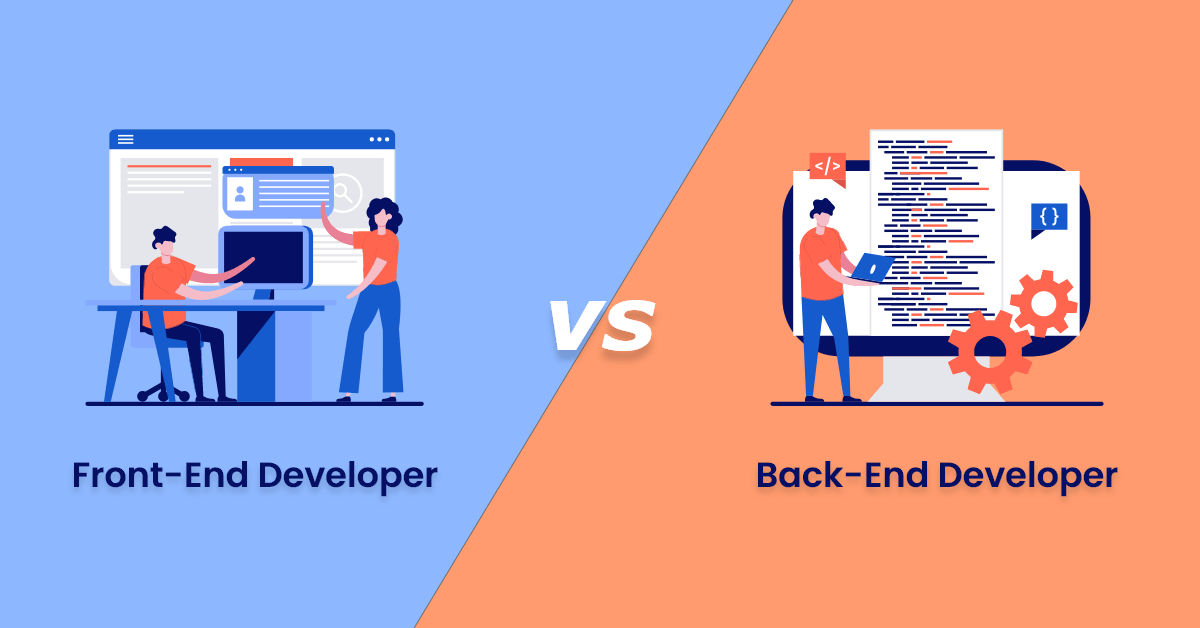Frontend vs Backend Developers: Key Differences

The emergence of new technology has resulted in the evolution of web development techniques and strategies with quickly evolving coding standards and improved infrastructure.
A web applications architecture is known as the medium that enables successful web development to hold the various parts together.
The two fundamental aspects of a web application architecture are Frontend and Backend.
The frontend and backend are nearly two of the most frequently used expressions in the computer business.
So, let’s talk about how these two names vary, why they exist, and the many pathways you might pursue in your software development career.
What is Web Development?
At its most basic level, web development entails the establishment of a website for usage on the internet.
The non-design aspect of a website is web development, which includes the construction of features and functionality using scripting languages, markup, and programming.
Developers are in charge of the technical components of website development, such as programming, graphics, layout, and integrating applications.
How Many Types of Web Development are There?
The back end and front end are two diverse career pathways in the technology sector.
Back-end developers are concerned with data, modeling, and the back-end of a website, among other things.
Front-end developers help to create the interfaces and visuals that users engage with.
Statistics of Web Development
According to the Bureau of Labor Statistics, the employment of web developers in the United States is expected to grow 27% between 2014 and 2024.
According to the stack overflow 2020 survey, 55.5%, 54.9%, and 37.1% of respondents identified themselves as backend, full-stack, and frontend developers, respectively.
What are the Key Differences?
What is a Front-end Developer?
Frontend developers are in charge of implementing visual components on a website.
They also carry out important websites development tasks such as navigation, buttons, and anything else that contributes to the overall visibility of the website.
To ensure that your website runs smoothly, HTML, JavaScript, and CSS are frequently used. This enables users to interact with a website freely and comfortably.
What is a Backend Developer?
Backend developers are responsible for server-side development.
They specialize in database administration, scripting, and website design.
These experts also keep track of how the site works, how to make changes, and how to keep all the behind-the-scenes features up to date.
How Do Frontend and Backend Developers Begin Working on a Project?
Developers create a proper plan before working on any project, and then they begin working on it.
Let’s take a look at how a Frontend Developer and a Backend Developer begin working on a project:
OneClick, a Custom Software Solutions Company, has a large Dedicated Development Team that is skilled in both Frontend and Backend Development.
Follow simple and transparent processes, avoid long-term contracts, and collaborate closely with you to ensure a successful engagement.
Skills of Front-end and Back-end Developer
Frontend developers work on the aesthetics and user interface of a website, thus they should be familiar with design software such as PhotoShop, Sketch, and Figma, as well as the programming languages listed above.
Frontend developers should also understand the fundamentals of web hosting and domain registration.
On the other hand, back-end developers must be able to think critically.
A backend developer is responsible for both debugging code and building methods for how users will interact with the website.
Backend developers should be able to answer the following questions:
- What is the location of data storage?
- Is it kept in a secure location?
- Will the site be able to handle a sudden increase in visitors without crashing?
- How can I add a new feature to the website without breaking it?
- How can I test a website (usually using a staging platform and/or test-driven development) to ensure that the end-user encounters the fewest possible difficulties and issues?
Technologies Needed for Front-end and Back-end Developer
For Frontend Development
The following are the key technologies used in frontend development:
HTML (HyperText Markup Language) is the programming language used to create the World Wide Web.
Developing and displaying Web pages, is the most extensively used text formatting language.
There are two sections to HTML files:
- The actual text, and
- The tags that format it for optimal page display.
CSS (Cascading Style Sheets) is the abbreviation for Cascading Style Sheets. For HTML elements, it’s a basic enough styling language. It’s common in web design, and it’s also used in XHTML.
JavaScript is a widely used client-side scripting language that is open-source and supported by a wide range of browsers.
JavaScript is used to improve a website’s interaction with the user.
For Backend Development
The following technologies are used in backend development:
Server: It is preferable to use server-side technologies such as Apache, Nginx, IIS servers, Microsoft IIS, and so on. When it comes to server administration, having a solid understanding of Linux is extremely beneficial.
Web Development Languages: Backend development entails the use of one or more server-side or backend programming languages, such as Java, Python, Ruby,.Net, and others.
API: APIs are also necessary for backend development. Technical knowledge of REST and SOAP service creation and consumption is required.
Database and Cache: Back-end development also covers DBMS technologies such as MySQL, MongoDB, Oracle, SQLServer, and Redis, as well as essential back-end development databases.
Roles and Responsibilities of Frontend Developer and Backend Developer
Sr No. | Frontend Developer | Backend Developer |
| 1 | Ensure that the site’s visibility is consistent across all browsers. | Recognize the client’s website or application goals and offer appropriate development solutions. |
| 2 | Knowledge of cross-browser testing. | Developing payment processing systems, storing payment information securely, and charging payment fees. |
| 3 | A fundamental grasp of SEO. | Building a system’s architecture and performing data science analysis |
| 4 | Excellent at interacting with customers and implementing their feedback. | Ability to solve system-related problems and implement algorithms |
| 5 | Developing a visually appealing website or app that also entices users to interact. | Data storage in a secure manner, with the goal of displaying it to the user when requested. |
| 6 | Knowledge of tools such as Flash and Dreamweaver. | Manage and (if necessary) create API resources that are cross-platform. |
| 7 | Designing for ease of use. | Organize the system’s logic such that it can function smoothly on numerous devices. |
Conclusion
We’ve covered a lot of ground in this article about Frontend vs Backend Developer.
The use of frontend and backend development is essential for website development, which is why it is difficult to predict who will win the Frontend vs Backend Developer war and we can even say that this is a never-ending war.
Nowadays, many startups, SMEs, and large corporations simply hire developers for website development or application development.
Still, they do not understand the use and distinction between frontend vs backend, and in order to develop a leading site, one should understand the same, as this will only help you to meet business objectives.
Hire Frontend developers to create an appealing website interface, and Hire Backend developers to create server-side websites.







